Quintana Roo

Pronunciation: keen-TAH-nah ROH-oh.
Origin of state name: The state was named after Andrés de Quintana Roo (1787–1851), who fought for Mexican independence.
Capital: Chetumal (cheh-too-MAHL).
Entered country: 1974.
Coat of Arms: A rising sun with seven rays represents the first seven municipalities of Quintana Roo. The symbol in the upper left represents a marine shell marking the state's position on the Caribbean. The five-pointed star symbolizes the "morning star," representing the planet Venus. It can generally be seen in the eastern sky just before sunrise and represents the state's position as the easternmost point of Mexico. The three triangles represent the forests of Quintana Roo. Red is the Mayan color to represent the east, yellow represents the south, white is the north, and black is the west. Green is a sacred color.
Holidays: Año Nuevo (New Year's Day—January 1); Día de la Constitución (Constitution Day—February 5); Benito Juárez's birthday (March 21); Primero de Mayo (Labor Day—May 1); Revolution Day, 1910 (November 20); and Navidad (Christmas—December 25).
Flag: There is no official state flag.
Time: 6 AM = noon Greenwich Mean Time (GMT).
1 Location and Size
Quintana Roo is the easternmost state at the tip of the Yucatán Peninsula. Quintana Roo covers an area of 42,030 square kilometers (16,228 square miles), which is a little less than half the size of the US state of Maine. It borders the Mexican states of Yucatán to the northwest, Campeche to the west, the Central American countries of Belize and Guatemala to the south, and the Gulf of Mexico and the Caribbean Sea to the east and north. The state has eight municipalities. Its capital is Chetumal.
Quintana Roo is situated on the Yucatán Peninsula, which is low and flat. The southwestern region of the peninsula is the highest, reaching an altitude of more than 200 meters (660 feet) above sea level. The Caribbean coastline is long and beautiful, with fine beaches. One important feature of this coastline is the coral reef.
The most important river is the Hondo River, which forms the border with Belize.
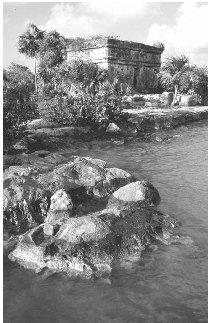
Mayan ruins.
2 Climate
The warm waters of the Caribbean Sea contribute to the climate, which is generally warm and humid. The average temperature range is 25.5° c to 26.5° c (78° f to 80° f ), with maximum high temperatures between 36° c and 38° c (97° f and 100° f ) and low temperatures ranging from 12° c to 14° c (54° f to 57° f ). The highest monthly average rainfall, 17 centimeters (6.7 inches), occurs in September. Annual rainfall ranges from 1,100 to 1,500 millimeters (43 to 59 inches), with the average being 1,200 millimeters (47 inches). The region is also frequently affected by tropical storms and hurricanes. In September 1989 Hurricane Hugo struck Cancún with 320-kilometer-per-hour (200-mile-per-hour) winds, causing major damage to the resort hotels there.
3 Plants and Animals
There are four basic ecosystems, or natural environments, found in the state: forests, savanna, mangroves, and reefs. The forests contain mahogany, cedars, East Indian rosewoods, and palm trees. Common animals in this ecosystem are anteaters, spider monkeys, white-tailed deer, and tepezcuintles (a type of dog). Birds found here include turkeys, parrots, doves, and nightingales. The savanna region features pastureland and bushes. Mangroves are tropical evergreen trees that generally grow along the coast and have large, tangled root systems. Animals found in the mangroves include herons, pelicans, and ducks. Manatees and alligators are also found in the nearby waters. The limestone reef that lies along the coast is the home of lobsters, shrimp, sea snails, and other fish.
4 Environmental Protection
There are several protected areas that are meant to preserve and sustain the diverse ecosystems of the state. These areas include Tulum National Park, the Yum Balam Protected Area, Sian Ka'an Biosphere Reserve, and El Eden Ecological Reserve.
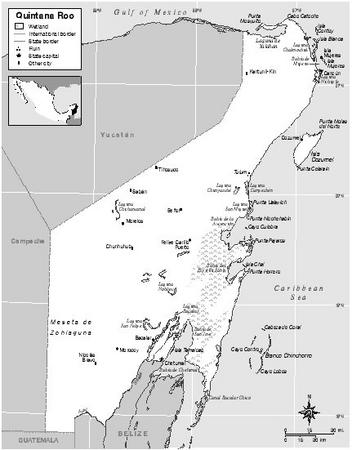
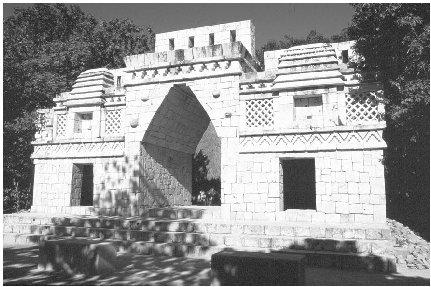
The Labna Arch was the entrance to the city of Labna, which flourished around 700–800 A . D .
5 Population, Ethnic Groups, Languages
Quintana Roo had a total population of 874,963 in 2000; of the total, 448,308 were men and 426,655 were women. The population density was 21 people per square kilometer (54 people per square mile). In 2000, the capital, Chetumal, had a population of 121,602.
Most citizens speak Spanish as a first language. However, about 23% of the population speaks indigenous (native) languages. This is the fourth-highest percentage in the country (following Yucatan, Oaxaca, and Chiapas).
6 Religions
According to the 2000 census, 63% of the population, or 552,745 people, were Roman Catholic; 10%, or 84,319 people, were Protestant. That year there were also 14,285 Seventh-Day Adventists, 16,919 Jehovah's Witnesses, and 587 Jews. Over 80,000 people reported no religion.
7 Transportation
Cancún International Airport, Chetumal International Airport, and Cozumel Airport provide international flights to and from Quintana Roo. The state has about 5,302 kilometers (3,293 miles) of roads.
8 History
Around 3000 B . C . proto-Mayan groups first populated the region. During the 10th century, a Mayan group known as the Itzáes built the cities of Chichén-Itzá and Champotón, two of the most impressive Mayan ruins that still exist in Mexico. Together with other groups influenced by the Toltec and Chichimec cultures, the Itzáes formed the Mayapan League, a sort of lose coalition of Mayan cities. In 1194, the Itzáes abandoned Chichén-Itzá. They founded the city of Petén, another celebrated Mayan architectural wonder.
In 1502, the first contact with Spanish conquistadors (Spanish explorers who sought to conquer Mexico for Spain) took place off the coast of Quintana Roo, where some of the members of Christopher Columbus's (1451–1506) last expedition discovered native fishing boats. In 1511, a Spanish ship from Darien (Panama) was stranded near the coast. Several survivors were captured and executed in the region with the exception of Gonzalo Guerrero and Jerónimo de Aguilar, who were accepted and assimilated into Mayan culture.
In 1517, the Hernández de Córdoba expedition arrived in Cabo Catoche and later Juan de Grijalba (c. 1489–1527) arrived in Cozumel. In 1519, Spanish conqueror Hernán Cortés (1485–1547) arrived in Chetumal and rescued Jerónimo de Aguilar. In 1526 , Francisco de Montejo (c. 1479–1553) proposed to Spanish king Carlos V (1500–1558) the conquest of the Yucatán province. The conquest was started in 1527 and completed in 1546 by Montejo's son, Francisco Montejo y León.
During the 16th and 17th centuries, pirates operating in the Caribbean constantly attacked the coastal regions. In 1652, the city of Salamanca de Balacar was attacked by buccaneers and then abandoned. Efforts were made to prevent a possible English invasion from the Belize territories. Catholic conversion efforts were first launched in the 18th century, allowing for the Maya population to retain much of its original cultural heritage well into the independence period.
After independence, in 1823, Guatemala annexed much of the Petén-Itzá territory. In 1841, an effort by large landowners to declare the independence of the Yucatán Peninsula from Mexico failed because of the lack of international recognition. In 1847, an ethnic war brought instability and destruction to the region. Mexico and Britain signed the Marshal Saint John Treaty that established the Belize-Mexico border on the Hondo River.
In 1901, the last indigenous rebels were subdued. In 1902, Quintana Roo was made an independent territory, autonomous of the Yucatán state. After being incorporated with Yucatán and Campeche during different phases of the Mexican Revolution, Quintana Roo was made an independent entity by President Lázaro Cárdenas (1895–1970), who served as president of Mexico from 1934 to 1940. The region became a federal state only in 1974.
Because of its innumerable natural beauties and its rich archeological and anthropological heritage, UNESCO incorporated the region into its Man and Biosphere Program in 1986. Aside from its growing and consolidating tourism industry, Quintana Roo remains a scarcely populated state with little industrial and non-tourism related economic activities. Two major factors have influenced Quintana Roo's slow growth: tourism has been widely promoted by the central national government and its late
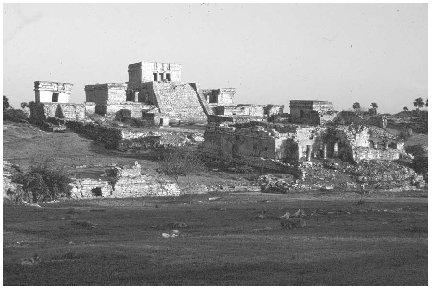
The ruins at Tulum are preserved as part of Tulum National Park.
9 State and Local Government
The state governor is elected for a six-year nonrenewable term. The state legislature is comprised of twenty-five deputies elected for nonrenewable three-year terms. Fifteen deputies are elected in single member districts and ten are elected by proportional representation. Although the constitution includes separation of power provisions, the governor exercises enormous influence over the legislature, reflecting the tight control the Institutional Revolutionary Party (PRI) has wielded over state politics since its beginning.
The eight municipalities that make up Quintana Roo hold democratic elections for municipal presidents and council members every three years. Immediate re-election is not allowed. Because the PRI continues to exercise strong power at the gubernatorial level, decentralization efforts have lagged behind in Quintana Roo.
10 Political Parties
The three main political parties in all of Mexico are the Institutional Revolutionary Party (PRI), the National Action Party (PAN), and the Party of the Democratic Revolution (PRD). The PRI has continued to dominate state politics, as it has in much of the country since the end of the Mexican Revolution. Although the PAN and PRD have received a considerable share of the vote in recent elections, the PRI remains as the strongest party in the state. There has yet to be a non-PRI governor in Quintana Roo since it became a federal state.
11 Judicial System
The Superior Tribunal of Justice is the highest court in the state. Its members are appointed by the legislature from a three-person list submitted to them by the Superior Tribunal. Only qualified attorneys can be included in the list. There is a mandatory retirement age of sixty-five. In addition, an electoral tribunal court and local courts complete the state's judicial system.
12 Economy
Tourism is the most important economic activity in Quintana Roo accounting for 80% to 90% of the economy. Cancún, once an uninhabited island, has grown to be one of the world's leading tourist destinations. Cancún secures 25% to 28% of all Mexican tourism. The number of hotel rooms and visitors has far exceeded projections. Agriculture, livestock breeding, forestry exploitation, apiculture (beekeeping), and fishing follow in importance. Industrial activities have barely gained footing in the economy. Exports are chicle (a chief ingredient of chewing gum), honey, seafood, and fruit.
13 Industry
Industrial activity in Quintana Roo is related to the tourism industry. Large-scale industry is in sugar and construction materials. Small-scale industry is in tortillas, bread, purified water, and ice. Otherwise, other activities have barely begun.
14 Labor
The US Bureau of Labor Statistics reported that Mexican workers saw their wages increase 17%, from $2.09 per hour in 1999 to $2.46 per hour in 2000. (The average US worker earned $19.86 per hour in 2000.) After one year, workers are entitled by law to six days paid vacation.
15 Agriculture
Agricultural products are corn, beans, rice, sugarcane, jalapeño chilies, and watermelon. Beekeeping products are honey and wax. Cattle, pigs, and sheep are the livestock bred.
16 Natural Resources
There is fishing for shrimp, lobster, and sea snails. Mahogany and cedar are forested. Chicle, a sticky white sap that may be used as the raw material for chewing gum and other products, is another forestry product found in both the high and low stature semi-evergreen forests of Quintana Roo.
17 Energy and Power
Almost all of the energy in Mexico is provided by the Federal Electricity Commission (CFE). In February 2002, the CFE introduced new electric rates. For households that use less than 140 kilowatt hours per month, there was no rate increase.
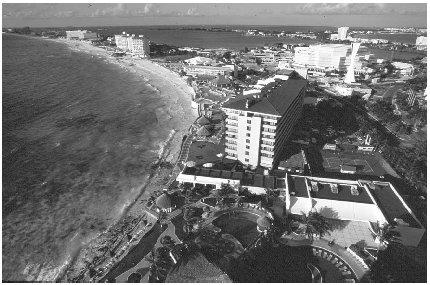
Cancun is a popular resort destination.
18 Health
The state of Quintana Roo has 15 general hospitals, 196 outpatient centers, and 28 surgical centers. There is also an AmeriMed center, an American hospital, in Cancún geared towards tourists and their families.
Most of the Mexican population is covered under a government health plan. The IMSS (Instituto Mexicano de Seguro Social) covers the general population. The ISSSTE (Instituto de Seguridad y Servicios Sociales de Trabajadores del Estado) covers state workers.
19 Housing
Only about one-half of the housing available in the state of Quintana Roo is in good repair. More than 26% is in need of significant upgrading. Many homes do not have running water or access to electricity. Population growth was more than double the national average in the mid 1990s, resulting in not enough housing to meet demands.
20 Education
The system of public education was first started by President Benito Juárez (1806–1872) in 1867. Public education in Mexico is free for students from ages six to sixteen. According to the 2000 census, there were approximately 139,600 school-age students in the state. Many students elect to go to private schools. The thirty-one states of Mexico all have at least one state university. The Universidad de Quintana Roo is located in the capital, Chetumal.
21 Arts
Quintana Roo has seven theaters and cultural centers. A principal cultural center is the Centro Cultural de Bellas Artes. There are displays of archeological artifacts from the city of Chetumal.
22 Libraries and Museums
There are forty-four branches of the library system in Quintana Roo. There is an archeological museum and a museum of popular art in Cancún. Cozumel also has a museum.
23 Media
Cancún, has one daily newspaper, Novedades Quintana Roo.
24 Tourism, Travel, and Recreation
The two main tourist attractions are the cities of Cancún and Cozumel. These are primarily tourist destinations, but they are also places from which people take off to visit famous archeological sites, such as Chichén-Itzá. Cozumel, a small island with excellent beaches, has many Mayan archeological ruins at San Gervasio. The Chankanaab Lagoon is a natural aquarium popular with snorkelers. The archeological city of Tulum is one of the main tourist attractions of Quintana Roo. Tulum was a Mayan site built on a cliff overlooking the Caribbean. Isla Mujeres (Isle of Women) offers diving and snorkeling. There is a large stone cross in the water dedicated to those who lost their lives there. Quintana Roo was also the site of the pirate trade.
25 Sports
Water sports are popular for both residents and tourists, who are drawn to the Caribbean beaches of the state.
26 Famous People
Quintana Roo was named after Andrés Quintana Roo (1787–1851), an early patriot of the Mexican Republic. Joaquín Ernesto Hendricks Díaz was elected governor of Quintana Roo in 1999, for a six-year term.
27 Bibliography
Books
Cancun and the Yucatan. London, Eng.: Dorling Kindersley, 2003.
DeAngelis, Gina. Mexico. Mankato, MN: Blue Earth Books, 2003.
Supples, Kevin. Mexico. Washington, DC: National Geographic Society, 2002.
Web Sites
Mexico for Kids. http://www.elbalero.gob.mx/index_kids.html (accessed on June 15, 2004).
but i would do a documentary on family life,
i had to change 1 of my slides to fiestas cause you didn't have that documentary! other than that this was the best informational website for quintana roo!
from,
steph